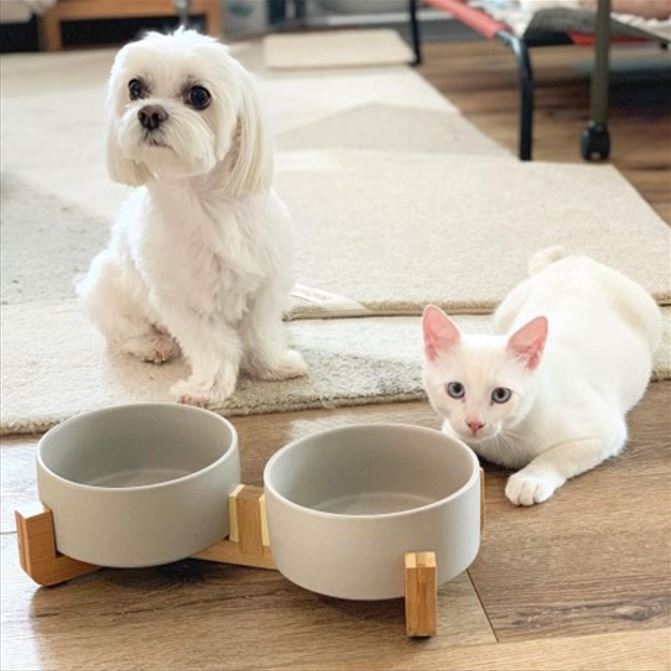Pets bring so much love to our lives that it is only natural for us to want to give them the best. Everybody knows someone in their neighborhood whose living room window is dominated by a multi-story cat tree or who always seems to be throwing a brand-new toy for their dog to fetch. While these kinds of toys and structures are great for improving pets’ health and happiness, sometimes going above and beyond for your furry friends can mean taking very simple steps as well.
Nothing seems simpler than choosing the right bowls in which to serve your pets’ food and water, and yet this small decision can have major impacts on your pets’ overall well-being. There are many options out there and lots of factors to consider when choosing between them, and the benefits and drawbacks of the different kinds are not always immediately apparent.
“While the quality of the food you give to your pet is obviously critically important, the type of bowl you serve it in is just as important,” says Sammi Wong, Founder and CEO of SpunkyJunky, a brand that makes top-quality food bowls for cats and dogs. “The type of bowl your pet eats out of can have a major impact on their appetite, posture, and risk of infection. It’s important to be informed before you make a purchase.”
Below are three major factors to consider when choosing bowls for your pets.
Ergonomics
Whether you work at a desk or in a warehouse, most of us are well aware of the importance of maintaining good posture and the discomfort that occurs when we put too much consistent strain on our bodies. However, not everyone is aware that our pets face similar problems. What’s more, it can often be hard to tell when a pet is experiencing discomfort, as they do not express or display ailments the same way that we do.
Placing food bowls on the floor forces pets to bend their necks and shoulders to reach the food. This can be painful and difficult for older pets or pets with arthritis, and feeding younger pets this way increases the likelihood that they will have mobility issues in the future. Moreover, for certain particular breeds–such as flat-faced cats–having bowls on the floor increases their likelihood of choking on food or inhaling water through their noses.
Having elevated bowls reduces the physical strain of eating, which not only improves their posture but actually boosts appetite. For some breeds, having bowls tilted at an angle makes eating even easier. "When a pet feels comfortable eating, they are more likely to eat the proper amount of food,” says Wong. “A slightly raised and tilted bowl can effectively relieve the pressure on the cervical spine of the pet, reducing the risk of conditions such as cervical spondylosis. These conditions do not just affect older pets, so it is important to start early.”
While it’s important to tailor your bowl choices to your pets’ particular body type and snout shape, opting for elevated bowls is almost always the way to go.
Cleanliness
When it comes to bowls, cleanliness means more than just ensuring that your pet does not bat the bowl around and spill food or water. It means ensuring that the bowl itself does not harbor potentially harmful bacteria that could increase your pets’ chances of contracting an infection.
“The cleanliness of food and water bowls is often something we don’t think about until it’s too late,” says Wong. “Part of this is because the risk is not always visibly obvious: harmful bacteria can hide in the minuscule cracks that occur in less durable materials. It’s a good idea to prevent these risks altogether by opting for bowls that are both durable and easy to clean.”
Opting for materials such as ceramic or stainless steel rather than cheaper plastic bowls helps greatly minimize the chances of your pet contracting an infection. These types of bowls are easy to clean and, in the case of ceramic bowls, their increased weight and solidity minimizes the potential for more enthusiastic eaters to bat the bowl around and make a mess.
Aesthetics
This aspect is more for you than your pet, but that doesn’t mean it’s not an important consideration. While some of the items we buy for our pets are beautiful compliments to home decor, others can be rather unsightly. Food bowls typically fall into this category, both because they frequently end up surrounded by kibble crumbs and split water and because their designs can sometimes look cheap or tacky.
While stainless steel bowls can have an appealing look in certain contexts, ceramic typically takes the cake in this category. This is because ceramic bowls can come in a variety of colors that tastefully complement any room’s color scheme. What’s more, they tend to be harder for pets to move around and thus tend to promote less messy eating, meaning that they don’t have to be hidden away in a kitchen or basement.
“All in all, the small choices are what really matter when it comes to our pets,” says Wong. “Things that may not seem important at first glance often turn out to be really significant when we really look into them. When it comes to our pets, we always want the best, so it’s important to take the time to figure out exactly what ‘the best’ is.”










